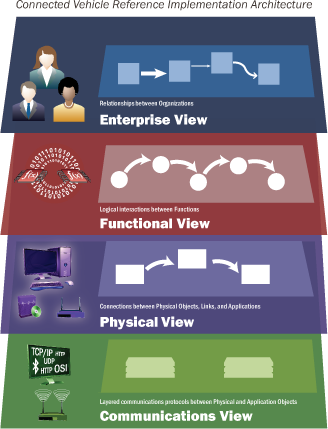Viewpoints

The diagram depicts the Connected Vehicle Reference Implementation Architecture (CVRIA) as a set of layered viewpoints - each providing a different perspective to understand the architecture.
The approach to develop a System Architecture in this way is based on ISO/IEC/IEEE 42010:2011, a standard for "Systems and software engineering — Architecture description." This includes steps to define, not just data and messages, but the full environment in which the stakeholder concerns are satisfied. The figure above identifies the four Viewpoints used to describe the CVRIA: Functional, Physical, Enterprise and Communication. While there is only one model per View, the models used result in a large number of diagrams per View. Only by considering all aspects of the model can one understand the scope of each Viewpoint and thus gain a complete picture the architecture.
The ISO Open Systems Interconnection (OSI) Model, an industry standard communications protocol model has parallels to some of these viewpoints. The seven layers of the OSI Model are more rigid, in that each layer of the OSI Model provides services to the layers above and receives services from the layers below. While Viewpoints are not so aligned from top to bottom, Viewpoints do include objects that mirror the relationships between OSI Model layers. Viewpoints tend to include objects that could be assigned to particular layers of the OSI Model:
- The Communications Viewpoint includes the OSI model layers 1-7, but focuses on layers 1-5 (Physical, Data Link, Network, Transport and Session)
- The Functional and Physical Viewpoints include functional components that align with Layer 7 (Application)
The links here will show you how to read and interpret the content shown on the architecture content pages.
- Enterprise: relationships between organizations
- Functional: logical interactions between functions
- Physical: connections between physical objects and their application objects
- Communications: layered communications protocols between application objects
A fifth perspective, unique to CVRIA, is the application perspective. This is not a viewpoint per se, but rather a way of looking at subsets of each view focused on a specific connected vehicle application. The applications are derived from the documentation like ConOps, System Requirements, standards, and other documents that have been written to describe parts of the connected vehicle environment. It should be noted that this is not an exhaustive list - new applications will be developed over time but these provide a comprehensive look at the connected vehicle environment.

Several rules guide the relationships between viewpoints. Generally speaking, elements in one view may be referenced in some fashion in at least one other view. Specific correspondence rules are:
- Physical Objects are defined with scope such that they are under the control of a single Enterprise Object.
- Application Objects provide functionality defined by PSpecs.
- Information Flows are characterized by Communications Characteristics, which imply various communications protocol standards.
- Information Flows are further defined by Data Flows.
- Information Flows are always accompanied by a provision agreement relationship. Such relationships are formal if both participants are centers or field equipment. They are nearly always informal if between two mobile objects. If between mobile and fixed, the relationship may be formal if personalized or individually targeted information is exchanged.
- Coordination relationships may imply Communications Characteristics:
- An expectation of guaranteed delivery drives non-repudiation of receipt.
- An expectation of information provision may drive regularity and periodicity.
- An expectation of personal information exchange drives a high confidentiality requirement.
- Physical object context may constrain Communications Characteristics:
- Information flows between two mobile objects (vehicle or personal) are always restricted to wireless media.
- Communications involving one mobile object and one fixed object involve wireless media, but may also include fixed media backhaul.
- Communications between two vehicles nearly always use 5.9 GHz DSRC and the IEEE 1609.x stack.